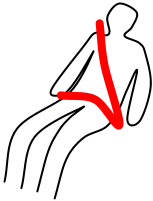Seat belt

A seat belt, sometimes called a safety belt, is a harness designed to hold the occupant of an car or other vehicle in place if a collision occurs. Seat belts are intended to reduce injuries by stopping the wearer from hitting hard interior elements of the vehicle or from being thrown from the vehicle. In cars seat belts also prevent rear-seat passengers from crashing into those in the front seats.
Types of seat belts
Lap: Adjustable strap that goes over the waist. Used frequently in older cars, now uncommon exxcept in some rear middle seats (also in passenger aircraft).
Sash: Adjustable strap that goes over the shoulder. Used mainly in the 1960's, but almost ineffective because it is very easy to slip out of in an accident, because there is no lap belt to hold you down.
Lap and Sash: Combination of the two above (two separate belts). Mainly used in the 1960s and 1970s, usually in the rear.
Three-point: three-point belts combine a sah and a lap belt in a single construction, securely anchored to strong points in the vehicle body. This helps spread out the energy of the moving body in a collision over the chest, pelvis, and shoulders. Until recently shoulder belts were commonly available only in the front seats of the cars, the back seats having only lap belts. Evidence of the potential for lap belts to cause separation of the lumbar vertebrae and the sometimes associated paralysis, or "seat belt syndrome", has led to a revision of safety regulations in nearly all of the developed world requiring that all seats in a vehicle be equipped with three-point belts.
Five-point harnesses are safer but more restrictive seat belts, typically found in child safety seats, and also in racing cars. The lap portion is connected to a belt between the legs and there are two shoulder belts, making a total of five points of attachment to the seat.
Inertia reel: Used almost universally today, inertia reel belts are effectively self-adjusting, which improves effectiveness. They also retract when not in use, reducing the chances of damage to the belts. A retractor reel lets out the strap or pulls it back as needed, and in the event of an accident the reel locks, preventing any more srap to come out and holding the passenger in the car. This may be augmented by pretensioners (see below).
History
Seat belts were first invented by George Cayley in the 1800s. Seat belts were introduced in aircraft in the 1930s. The automotive seat belt was introduced into the United States by William Myron Noe, whose patented quick release seat belt, the AutoCrat Safety Belt, was the first seat belt installed as original equipment in the US by Ford in its 1956 model year. The first seatbelt to be included as strandard was on the 1959 Volvo. However, they were not required by law in the US on passenger vehicles until the 1968 model year.
Three point harnesses were first made readily available in mass-produced vehicles by Volvo. It was Swedish engineer Nils Bohlin who patented the modern three-point belt design and gave it to Volvo.
Mechanism
Most seat belts are equipped with locking mechanisms that tighten the belt when pulled hard (e.g. by the force of a passenger's body during a crash) but do not tighten when pulled slowly. Many are also equipped with 'pretensioners', which preemptively tighten the belt to prevent the passenger from jerking forward in a crash.
Autoliv Corporation first developed pretensioners in 1986. In the event of a crash, a pretensioner will tighten the belt almost instantaneously. This reduces the load on the occupant in a violent crash. Like airbags, pretensioners are triggered by sensors in the car's body, and most pretensioners use explosively expanding gas to drive a piston that retracts the belt. Pretensioners also lower the risk of "submarining", which is when a passenger slides forward under a loosely worn seat belt.
See the page http://auto.howstuffworks.com/seatbelt.htm for more.
Legislation and Risk Compensation
The issue of seat belt legislation has been a source of some controversy. Hospital based studies of car accident victims, experiments using both crash test dummies and actual human cadavers have indicated that wearing seat belts should provide a reduced risk of death and injury in many types of car crash. This has led many countries to adopt mandatory seat belt wearing laws. It is generally accepted that, in comparing like-for-like accidents, a vehicle occupant wearing a properly fitted seatbelt has a significantly lower chance of death or serious injury.
However, the effects of such laws are disputed, stemming from the observed fact that no country is able to demonstrate a reduction in road fatalities due to passage of a seat belt law, though deaths have in some cases been migrated from drivers to other road users. This has influenced the development of risk compensation theory, which says that drivers adjust their behaviour in response to the increased sense of personal safety wearing a seat belt provides. In one trial habitual wearers and non-wearers were asked to drive round a course a number of times under the pretence of testing different seat belt materials for comfort. It was found that non-wearers drove consistently faster when belted than when unbelted (similar responses have been shown in respect of ABS braking and, more recently, airbags). It is also possible that the types of injury modelled in the trials were only a subset of potential serious injuries - for example, oblique impacts may produce twisting forces on the head leading to diffuse axonal injury, a particularly serious type of brain injury.
Put simply, then: if your are involved in a crash, you are almost always better off wearing a seat belt. But the probability of your being in a crash in the first place may well be affected by the fact that you feel safer, so the overall safety benefit may be offset to some unspecified degree.
